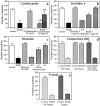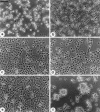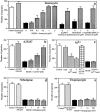Cross talk between adhesion molecules: control of N-cadherin activity by intracellular signals elicited by beta1 and beta3 integrins in migrating neural crest cells
- PMID: 9199179
- PMCID: PMC2137812
- DOI: 10.1083/jcb.137.7.1663
Cross talk between adhesion molecules: control of N-cadherin activity by intracellular signals elicited by beta1 and beta3 integrins in migrating neural crest cells
Abstract
During embryonic development, cell migration and cell differentiation are associated with dynamic modulations both in time and space of the repertoire and function of adhesion receptors, but the nature of the mechanisms responsible for their coordinated occurrence remains to be elucidated. Thus, migrating neural crest cells adhere to fibronectin in an integrin-dependent manner while maintaining reduced N-cadherin-mediated intercellular contacts. In the present study we provide evidence that, in these cells, the control of N-cadherin may rely directly on the activity of integrins involved in the process of cell motion. Prevention of neural crest cell migration using RGD peptides or antibodies to fibronectin and to beta1 and beta3 integrins caused rapid N-cadherin-mediated cell clustering. Restoration of stable intercellular contacts resulted essentially from the recruitment of an intracellular pool of N-cadherin molecules that accumulated into adherens junctions in tight association with the cytoskeleton and not from the redistribution of a preexisting pool of surface N-cadherin molecules. In addition, agents that cause elevation of intracellular Ca2+ after entry across the plasma membrane were potent inhibitors of cell aggregation and reduced the N-cadherin- mediated junctions in the cells. Finally, elevated serine/ threonine phosphorylation of catenins associated with N-cadherin accompanied the restoration of intercellular contacts. These results indicate that, in migrating neural crest cells, beta1 and beta3 integrins are at the origin of a cascade of signaling events that involve transmembrane Ca2+ fluxes, followed by activation of phosphatases and kinases, and that ultimately control the surface distribution and activity of N-cadherin. Such a direct coupling between adhesion receptors by means of intracellular signals may be significant for the coordinated interplay between cell-cell and cell-substratum adhesion that occurs during embryonic development, in wound healing, and during tumor invasion and metastasis.
Figures












References
-
- Akitaya T, Bronner-Fraser M. Expression of cell adhesion molecules during initiation of and cessation of neural crest cell migration. Dev Dyn. 1992;194:12–20. - PubMed
-
- Akiyama SK, Hasegawa E, Hasegawa T, Yamada KM. The interaction of fibronectin fragments with fibroblastic cells. J Biol Chem. 1985;260:13256–13260. - PubMed
-
- Behrens J, Vakaet L, Friis R, Winterhager E, Van Roy F, Mareel MM, Birchmeier W. Loss of epithelial differentiation and gain of invasiveness correlates with tyrosine phosphorylation of the E-cadherin/β-catenin complex in cells transformed with a temperature-sensitive v-SRC gene. J Cell Biol. 1993;120:757–766. - PMC - PubMed
Publication types
MeSH terms
Substances
LinkOut - more resources
Full Text Sources
Other Literature Sources
Research Materials
Miscellaneous

